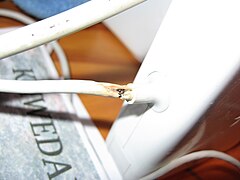MagSafe
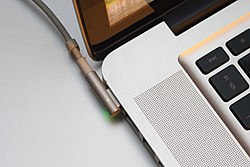 An L-shaped first-generation MagSafe connector in use on a MacBook Pro | |||
| Type | Computer power connector | ||
|---|---|---|---|
| Production history | |||
| Manufacturer | Apple Inc. | ||
| Produced | 2006–2019, 2021–present | ||
| Superseded by | USB-C (2016-2021) | ||
| General specifications | |||
| Hot pluggable | Yes | ||
| External | Yes | ||
| Pins | 5 | ||
| Pin out | |||
 | |||
| Male MagSafe 1 connector, front view | |||
| Pin 1 | GND (0 V) | ||
| Pin 2 | V+ (14.5 / 16.5 / 18.5 / 20 V DC) | ||
| Pin 3 | Charge control pin | ||
| Pin 4 | V+ (14.5 / 16.5 / 18.5 / 20 V DC) | ||
| Pin 5 | GND (0 V) | ||
| Gray area indicates magnetic connector shroud | |||
MagSafe is a series of proprietary magnetically attached power connectors developed by Apple Inc. for Mac laptops. MagSafe was introduced on January 10, 2006, in conjunction with the MacBook Pro, the first Intel-based Mac laptop, at the Macworld Expo. The connector is held in place magnetically so that if it is tugged (for example, by someone tripping over the cord) it will pull out of the socket without damaging the connector or the computer power socket, and without pulling the computer off of its surface.[1] A thinner and wider version, called MagSafe 2, was introduced in 2012. It was discontinued across Apple's product lines between 2016 and 2019 and replaced with USB-C. MagSafe returned to Mac laptops with the introduction of updated MacBook Pro models with MagSafe 3 in 2021.
History[]
The basic concept of MagSafe is derived from the magnetic power connectors that are part of many deep fryers and Japanese countertop cooking appliances since the early 2000s in order to avoid spilling their dangerously hot contents.[2][3][4] MagSafe was introduced on January 10, 2006 in the first-generation MacBook Pro.[5] Apple was granted US Patent No. 7311526 for MagSafe ("Magnetic connector for electronic device", issued in 2007) as MagSafe was deemed to be a sufficient improvement due to the connector being symmetrical and reversible, and the fact that magnets within a connector are arranged in opposing polarities for improved coupling strength.
Apple phased out MagSafe with the release of the 12-inch MacBook and 2016 MacBook Pro that replaced it with USB-C for charging and data.[6][7] The last product with MagSafe, the 2017 MacBook Air, was discontinued on July 9, 2019.[8] The MagSafe connector returned in 2021 with the introduction of updated 14-inch and 16-inch MacBook Pro models.[9]
Apple also uses the MagSafe name for a wireless power transfer and accessory-attachment standard for the iPhone based on the Qi standard, introduced with the iPhone 12 and 12 Pro.[10]
Features[]
MagSafe (original)[]
MagSafe has connector pins that are designed so the rectangular connector can be inserted in either orientation. Originally the connector was T-shaped, with the cable directed straight out; later it became L-shaped, with the cable directed along the side of the computer, but still capable of being inserted in either orientation, unless simultaneous use of neighboring ports such as USB required directing the cable toward the rear. LEDs on both the top and bottom of the connector show green if the computer battery is fully charged and amber or red if the battery is charging. MagSafe can be found on the MacBook (2006–2011), MacBook Pro (2006–2012) and MacBook Air (2008–2011) notebook computers. The Apple LED Cinema Display and Thunderbolt Display include built-in MagSafe chargers.[11]
The MacBook and the 13-inch MacBook Pro use a 60 W MagSafe charger, whereas the 15- and 17-inch MacBook Pro use an 85 W version. The MacBook Air used a lower-powered 45 W version. According to Apple, an adapter with a higher wattage than that originally provided may be used without problems.[12]
Apple formerly offered a "MagSafe Airline Adapter" for use on certain compatible airplanes. It had a DC input (instead of AC like the original MagSafe chargers) and would power the computer, but would not charge the battery.[13]
MagSafe 2[]

MagSafe 2 was introduced on the MacBook Air and MacBook Pro with Retina Display at the 2012 Worldwide Developers Conference on June 11, 2012. It was made thinner to fit the thinner laptops, and also wider to preserve magnetic grip force. It also returns to the T-shaped design that points straight out, rather than the L-shape that runs along the side of the machine.[14] MagSafe 2 can be found on the MacBook Pro (2012–2015) and MacBook Air (2012–2017) notebook computers.
The resulting shape is incompatible with the older MagSafe connector; Apple released a MagSafe to MagSafe 2 adapter that was also bundled with the Thunderbolt Display, which used the original MagSafe connector.
MagSafe 3[]
On October 18, 2021, Apple announced updated 14-inch and 16-inch MacBook Pro models with MagSafe 3.[15] MagSafe 3 is slimmer than its predecessor and connects to a power supply using a removable cable with a USB-C end. It supports up to 140W power delivery on the 16-inch MacBook Pro with its bundled 140W GaN power supply that supports USB-C Power Delivery 3.1.[16]
Pinout[]
The MagSafe connector pins allow for the adapter to be inserted in either orientation. The first and second pins on each side of the tiny central pin have continuity with their mirror pins.
- The inner large pins are V+ (14.5 / 16.5 / 18.5 / 20 V DC). Measuring with no load will give 6.86 V DC for MagSafe and about 3 V DC for MagSafe 2; the full voltage is provided after a ~40 kOhm load is applied for one second.[17]
- The outer large pins are ground.
- The tiny center pin is a data pin using the 1-Wire protocol. The computer uses this pin to change the LED's color and retrieve the serial number and wattage of the power supply.[17]
- Only two wires, power and ground, go to the charger unit. There is no data communication via the adapter sense pin with the charger unit itself.[17]
- The maximum voltage supplied is as follows:
- 14.5 V DC for the 45 W units supplied with MacBook Air
- 16.5 V DC for the 60 W units supplied with MacBook and 13" MacBook Pro
- 18.5 V DC for the 85 W units supplied with 15" and 17" MacBook Pro
- 20 V DC for the 85 W units supplied with 15" MacBook Pro Retina
The rectangular metal shroud surrounding the pins acts as shielding for the electrical pins and a ferrous attractor for the magnet in the laptop.
Third-party products[]
Apple does not license the MagSafe connector to third-parties, though manufacturers devised a workaround: their MagSafe items use the actual connector from Apple's AC adapter, grafted onto their own products. Since this uses an actual Apple product, purchased legally, manufacturers believe that no licensing agreements are needed (a principle referred to as the first sale doctrine) and no patent was violated.[18] However, in 2010 Apple still sued one such manufacturer, for selling its very popular HyperMac battery extension products which Apple claimed violated their patents.[19] Sanho has since ceased to sell their connector cable for the HyperMac series of external batteries.[20]
Some fake MagSafe 2 chargers have appeared on sites such as Amazon. These chargers are often unsafe, have spelling mistakes on the charger itself, and/or have inconsistencies that the official product does not contain, e.g. the LEDs on the connector do not follow the correct color code, or the charger is referred to as a MagSafe 1 charger rather than the second generation charger.
Defects[]
This section needs additional citations for verification. (June 2016) |
Many users have reported (as of 30 October 2011) problems with the quality of the construction of the MagSafe cords, giving the product low marks on the Apple Store's website.[21] Common complaints included plug separating from the cord, transformer shorting, and pin springs losing elasticity.[21]
Several methods have been devised to protect the MagSafe from failure, including wrapping the cable with tape or sliding protective plastic around the cable.[22]
In 2008, Apple posted an official response acknowledging problems with MagSafe adapters, which include incomplete circuit connection and adapter's white insulation separating from the magnetic end of the MagSafe connector.[23] Following the release of a Knowledge Base article, a class-action lawsuit was filed on May 1, 2009, in the US District Court for the Northern District of California's San Jose office, alleging that the MagSafe power adapter is prone to frayed wires and overheating, and as such represents a fire hazard.[24]
Apple released a firmware update in October 2010 that it claims resolves this issue.[25] However, the installer for the firmware update will not run on certain older MacBooks, which means that the firmware can not be updated. This, in turn, means that it is not possible to use the new MagSafe power adapter with these MacBooks. However, as of 2017, Apple still sells the older MagSafe power adapter.[26]
In 2011, Apple posted a support document about the strain-relief problems with the MPM-1 ("T")-style MagSafe power cables, and issued settlement offer for buyers of Apple 60 W or 85 W MagSafe MPM-1 adapter within the first three years of purchase.[27]
Gallery[]
This section contains an unencyclopedic or excessive gallery of images. |
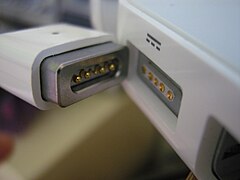
The first generation MagSafe Power Adapter that shipped with original MacBook and MacBook Pro
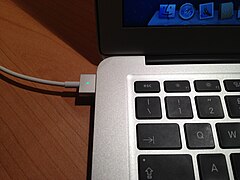
The second generation MagSafe Power Adapter that shipped with 2012-onwards MacBook Pro and post-2012 MacBook Air models.
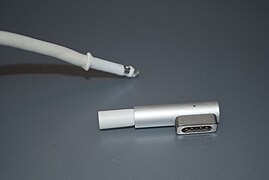
L-shaped MagSafe connector, broken off its power cord
MagSafe with both frayed wires and melted casing, as alleged in the 2009 class action lawsuit
References[]
- ^ "Apple Unveils New MacBook with Intel Core 2 Duo Processors" (press release). Apple Inc. 8 November 2006.
- ^ Vallese, Julie (4 July 2001). "'Break-Away' Cord Aims To Make Deep Fryers Safer". CNN. Retrieved 9 July 2012.
- ^ "Break Away Power Cords, Durez 152". www.dowell.com.hk. Retrieved 9 June 2019.
- ^ Prior art for Apple's Magsafe. Patents Stack Exchange
- ^ Bowe, Tucker (28 May 2020). "What Ever Happened to One of the MacBook's Best Features?". Gear Patrol. Retrieved 14 October 2020.
- ^ Fleishman, Glenn (12 March 2015). "Will your new MacBook crash to the ground without MagSafe? (Yes.)". Macworld. Retrieved 28 October 2016.
- ^ Kastrenakes, Jacob (27 October 2016). "Apple is killing off MagSafe, one of the MacBook's best features". The Verge. Retrieved 28 October 2016.
- ^ July 9, Phillip Tracy |; Am, 2019 09:23. "Apple Just Killed the MacBook Air with Good Keyboard and 12-inch MacBook". www.laptopmag.com. Retrieved 13 July 2019.
{{cite web}}: CS1 maint: numeric names: authors list (link) - ^ "Apple's latest MacBook Pros have MagSafe, SD card slots and camera notches". Engadget. Retrieved 18 October 2021.
- ^ Screen Rant: Does iPhone 13 Have MagSafe? Here's What You Should Know "The back of every iPhone 13 has a series of magnets that work with cases, chargers, etc. MagSafe-compatible accessories line up with these magnets"
- ^ "MacBook". Apple Inc.
- ^ "Intel-Based Apple Portables: Identifying the Right Power Adapter and Power Cord". Apple Inc.
- ^ "Apple MagSafe Airline Adapter". Apple Inc. Archived from the original on 14 May 2011.
- ^ "One of Apple's Best Ideas Ever — Made Worse", The New York Times, 30 July 2012, archived from the original on 1 June 2020
- ^ "Apple brings MagSafe 3 to the new MacBook Pro". The Verge. Retrieved 19 October 2021.
- ^ Porter, Jon (19 October 2021). "Apple's new 140W charger can fast charge a lot more than just your MacBook Pro". The Verge. Retrieved 19 October 2021.
- ^ a b c Shirriff, Ken. "Teardown and exploration of Apple's Magsafe connector". Retrieved 3 December 2013.
- ^ Frakes, Dan (15 June 2007). "A Third-Party MagSafe Solution?". Mobile Mac (blog of Macworld). Retrieved 9 July 2012.
- ^ "US District Court for the District of Northern California, Apple Inc. v Sanho Corporation" (PDF format).
- ^ Cheng, Jacqui (18 October 2010). "HyperMac To Halt MagSafe Sales, Hopes To Appease Apple". Ars Technica. Retrieved 9 July 2012.
- ^ a b "MA538LL/B". Apple Inc. Archived from the original on 19 February 2008.
- ^ Frakes, Dan (29 August 2008). "Mac MagSaver Protects Your MagSafe Connector". Mobile Me (blog of Macworld). Retrieved 9 July 2012.
- ^ Smykil, Jeff (20 August 2008). "Some MagSafe Adapters Being Replaced by Apple". Ars Technica. Retrieved 9 July 2012.
- ^ Foresman, Chris (5 May 2009). "Apple Sued over Reputed Fire Hazard of MagSafe Power Adapter". Ars Technica. Retrieved 9 July 2012.
- ^ "MacBook SMC Firmware Update 1.4". Knowledge Base. Apple Inc.
- ^ "Power & Cables". Mac Accessories. Retrieved 9 June 2019.
- ^ Cheng, Jacqui (8 November 2011). "Frayed MagSafe Power Connector? There's Now a Settlement for That". Ars Technica. Retrieved 9 July 2012.
External links[]
| Wikimedia Commons has media related to MagSafe. |
- "The Power of Magnets". Ars Technica (review). MacBook Pro. 1 March 2006. Part of the Ars Technica review of the MacBook Pro is dedicated to the MagSafe connector.
- "Where Are the MagSafe Adapters for Cars and Airplanes?". ZDNet. 28 June 2006.
- "MagSafe" (patent). Apple Inc.
- Apple Inc. hardware
- DC power connectors
- Products introduced in 2006



